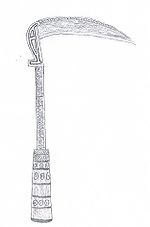- Lohar
-
Lohar 
Angaben Waffenart: Streithammer, Kriegssichel Bezeichnungen: Khyber-War-Sickle Verwendung: Waffe, traditionelle Waffe Entstehungszeit: etwa 17. Jh Einsatzzeit: bis heute Ursprungsregion/
Urheber:Afghanistan, Banockie-Stamm am Khyber-Pass Verbreitung: Afghanistan Gesamtlänge: etwa 20 cm Klingenlänge: etwa 40 cm Griffstück: Metall Listen zum Thema Die Lohar (auch Khyber-War-Sickle) ist eine Streitsichel der Banochie, eines Stammes in Afghanistan, die nahe dem Khyber-Pass leben.
Inhaltsverzeichnis
Geschichte
Die Lohar wurde vom Banochie-Stamm, der zu den Khyber-Stämmen gehört, entwickelt. Er ist neben einer Waffe auch ein Statussymbol des Trägers. Jeder Mann des Stammes fertigt seinen Lohar selbst und versieht diesen mit seinem eigenen Dekor und seinen persönlichen Zeichen.
Beschreibung
Die Klinge der Lohar ist gebogen und gleicht einem Vogelschnabel oder einer Sichel. Sie ist am Heft (Griff) breit und läuft zum Ort (Spitze) hin spitz zu. Die nach unten gerichtete Seite der Klinge ist scharf. Die Klinge steht im rechten Winkel vom Stiel ab. Klinge, Stiel und Heft bestehen aus einem Stück. Der Heft ist zu Zierzwecken mit Messing, Holz, Knochen oder Elfenbein überzogen. Die ganze Lohar besteht aus Stahl und ist auf seiner ganzen Fläche mit Symbolen verziert. Die Lohar hat eine Gesamtlänge von etwa 40 cm. Manche Lohar sind so konstruiert, dass die Klinge und der Heft zum Stiel hin eingeklappt werden können[1].
Einzelnachweise
- ↑ George Cameron Stone, Donald J. LaRocca, A Glossary of the Construction, Decoration and Use of Arms and Armor: in All Countries and in All Times, Verlag Courier Dover Publications, 1999, Seite 418-419, ISBN 978-0-486-40726-5
Siehe auch
Weblinks
Wikimedia Foundation.
